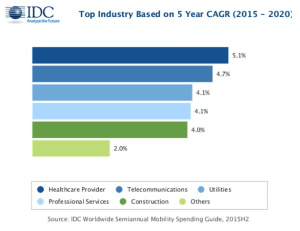According to IDC, in a recent report, global mobility revenues will continue to grow to reach 1.7 billion dollars by 2020, starting at 1.5 billion dollars in 2016, what represents a growth of 2.2% accumulated equivalent to forty thousand million dollars. Moreover, in this growth, the strong increase in software investments will play a key role.
Key drivers of the mobility market
Mobility revenues will come primarily from consumer and business purchases, from hardware (such as smartphones, laptops or tablets) and services (such as connectivity services), according to the IDC report. Software revenues, however, will experience double-digit growth through 2020, primarily as companies invest in mobile application development platforms, mobile enterprise applications and mobile enterprise security.
Carrie MacGillivray, Vice President of Mobility and Internet of Things, points out that “despite the belief that the mobility market is maturing, there are still plenty of opportunities to drive business spending, especially in the software. By 2020, the software market will increase spending by 15%, driven by the development of mobile applications and mobile security capabilities.”
While consumer spending generates more than half of mobility revenues, the banking sector is leading investments in mobility solutions, with a forecast of more than 100 thousand million dollars by 2020 according to IDC.
Together with banking, consumer goods production, professional services and retail trade, they are also investing heavily in mobility, while the healthcare industry will be the one to achieve faster revenue growth (5.1%) for this period, followed by telecommunications, professional services and public services, all of them above 4%.

From a business size perspective, large and very large companies (with more than 500 employees) will outperform general market investments, focused on mobile solutions that improve worker productivity, while small offices with less than a dozen employees will continue to invest in mobile devices and applications as an affordable alternative to traditional IT solutions.
From the regional point of view, Asia/Pacific (excluding Japan) will be the largest global mobility market in terms of income; in this region, China will lead investments with estimated revenues of 500 thousand million dollars by 2020.
The United States will be the second region, with a projected growth of 4.7%, followed by Latin America, the Middle East and Africa (EMEA), which will also see a revenue growth above the general market.
 Subscribe
Subscribe
 Ask for a demo
Ask for a demo

 2 min
2 min
